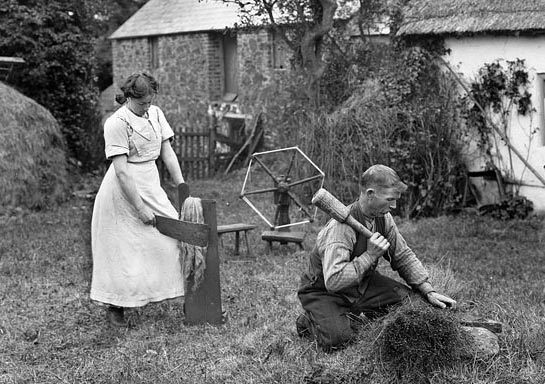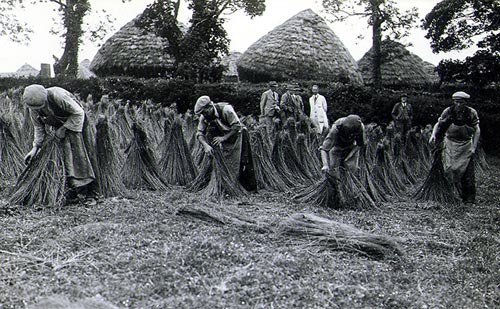Back in the late 18th-century spinning wheels were supplied, by the then Irish Linen Board, to Tipperary individuals, in an ambitious scheme undertaken to encourage the growing/farming of Flax.
Nationally, some 60,000 linen workers, became involved, which in turn assisted the development of a vibrant Irish linen industry. Irish Damask linen, developed in the 18th century, would go on to grace the dining tables of Royalty and the lesser landed gentry across the world, thus providing employment at a local level here in Co. Tipperary and nationally for centuries.

Since ancient times, Flax, also known as Linseed, from which linen is manufactured, had been growing in Ireland. Proof of flax curing has been uncovered in Irish bogs, dating back over two thousand years.
Early Irish Brehon Laws dictated that every farmer had to learn and practice the cultivation of Flax. In Tudor times, between 1485 and 1603, the production of linen was so great in Ireland that a law had to be passed banning the practise of ‘leaching’ and ‘water retting’ in rivers, to protect against the poisoning of fish stocks.
[Leaching and Retting: A process employed to facilitate the controlled rotting of cellular tissues, on Flax, thus separating the fibre from the stem of the plant.]
Labourers offloaded their flax plants into ponds, rivers, or retting dams and let it ‘ret’ for up to two weeks. Those farming then set up what were called flax ‘chapels’, rather like ‘stooked’ grain sheaves; latter supporting each other to be dried by the prevailing wind.

Back in 1796, the Board of Trustees of the Linen and Hempen Manufactures of Ireland (1711-1823) wished to encourage more farmers to grow flax and hemp seed to meet a ready demand. Spinning wheels, and looms, were awarded in proportion to the acreage sown. This incentive, encouraged small farmers to allocate part of their land to flax and hemp crops. County inspectors were appointed to receive claims from the growers and county lists were published as official documents of the Board.
A quarter-acre of flax grown would have qualified for one spinning wheel and for those who grew over five acres, a loom to the value of fifty shillings was granted.
Named Flax Growers of County Tipperary, 1796
| NAME | Town/Village | County |
| Archer William, | Drom, | Co. Tipperary. |
| Brien Patrick, | Templebredon, | Co. Tipperary. |
| Brook William, | Caher, | Co. Tipperary. |
| Burke Patrick, | Nenagh, | Co. Tipperary. |
| Burne Darby, | Emly, | Co. Tipperary. |
| Conners James, | Nenagh, | Co. Tipperary. |
| Doherty William, | Doon, | Co. Tipperary. |
| Henecy John, | Cloneen, | Co. Tipperary. |
| Hurley Timothy, | Drom, | Co. Tipperary. |
| Keesse David, | Emly, | Co. Tipperary. |
| Kinkade Richard, | Emly, | Co. Tipperary. |
| Long Robert, | Knockgraffon, | Co. Tipperary. |
| M’Donnel Arthur, | Nenagh, | Co. Tipperary. |
| M’Donnell Charles, | Drom, | Co. Tipperary. |
| Marnane John, | Lattin, | Co. Tipperary. |
| Marnane Thomas, | Solloghodbeg, | Co. Tipperary. |
| Meagher Daniel, | Templebredon, | Co. Tipperary. |
| Murphy Cornelius, | Emly, | Co. Tipperary. |
| Parker Roger, | Nenagh, | Co. Tipperary. |
| Parker William, | Kilmurry, | Co. Tipperary. |
| Parkinson William, | Drom, | Co. Tipperary. |
| Ryan James, | Capagh, | Co. Tipperary. |
| Ryan Samuel, | Nenagh, | Co. Tipperary. |
| Saunders Adam, | Doon, | Co. Tipperary. |
| Stokes Mary, | Nenagh, | Co. Tipperary. |
| White James, | Knockgraffon, | Co. Tipperary. |
Small cottage industries thrived across Ireland until large factory-type production began in the 1830s, providing water-powered scutching (beating), washing and beetling mills (beetling the pounding of linen or cotton fabric to give a flat, lustrous sheen was achieved). Irish industrialised linen production occupied both men, women and children, latter who worked to steep, scutch, spin, weave and bleach, latter stage using lime.
In the Census of Ireland in 1911 there where 456 people nationally whose occupations are recorded as ‘Flax Scutchers’.
Are there any persons occupied as ‘Scutchers‘ in Co. Tipperary today?

Leave a Reply